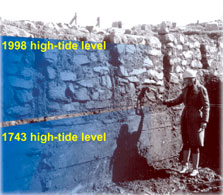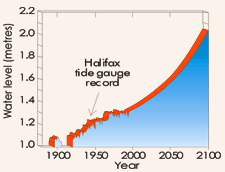Proactive disclosure
Print version   |  | 
Natural Resources Canada > Earth Sciences Sector > Priorities > Climate Change Impacts and Adaptation > Climate Change in Canada
The tides of change: Climate change in Atlantic Canada Rising sea level and vanishing coasts
Rising sea level

(Photograph courtesy of Parks Canada) |

Unfortunately, in Atlantic Canada (except Labrador) sea level has been rising for thousands of years, mainly because the Earth's crust in this area is sinking. This is illustrated by the mooring rings at Fortress Louisbourg, Cape Breton Island (above left). The predicted increase will be ADDED to the increase already happening. Here we see the tide gauge record of rising sea level at Halifax (36 cm/century) and the predicted rise by 2100 AD.
Vanishing coasts
The coast at Chezzetcook Inlet, near Halifax, has changed dramatically since the 1950s. The 1992 air photo (left) shows no sign of Misener's Island, which was eroded away in the 1970s. The 1920s photo (below) is a view from the island towards mainland. Coasts throughout Atlantic Canada will experience similar or greater change in the future.

(Photograph courtesy of J. Hawkins) |
The Intergovernmental Panel on Climate Change predicts that global sea level may increase 50 cm by 2100 due to warming of the oceans, melting of glaciers, and other effects.
Much of the coast of Atlantic Canada is highly sensitive to the effects of sea-level rise. The most sensitive coasts (shown here in red) are commonly low-lying, with salt marshes, barrier beaches, and lagoons. They will experience such effects as increased erosion, rapid migration of beaches, and flooding of coastal freshwater marshes.
Did you know?
Erosion is not necessaily bad! Eroded material may help beaches keep their 'heads above water' as sea level rises.
 Why is Canada's coast in the Guinness Book of Records? Why is Canada's coast in the Guinness Book of Records?
Erosion

(Photograph by D.L. Forbes. GSC 2001-010) |

Pointe Verde lighthouse
(Photo : J. Shaw. GSC 2001-009) |
Rising sea level will increase wave-energy at the coast, and intensify rates of change. Sights such as the road to Rustico Island, Prince Edward Island (above) will become more common. We may have to decide whether to abandon structures such as this, or invest in coast defences. Coastal bluffs are already retreating in Atlantic Canada, sometimes up to 12 m in a single year. The erosion threatening the lighthouse at Pionte Verde, Newfoundland (right), will be more prevalent in the future.
|

